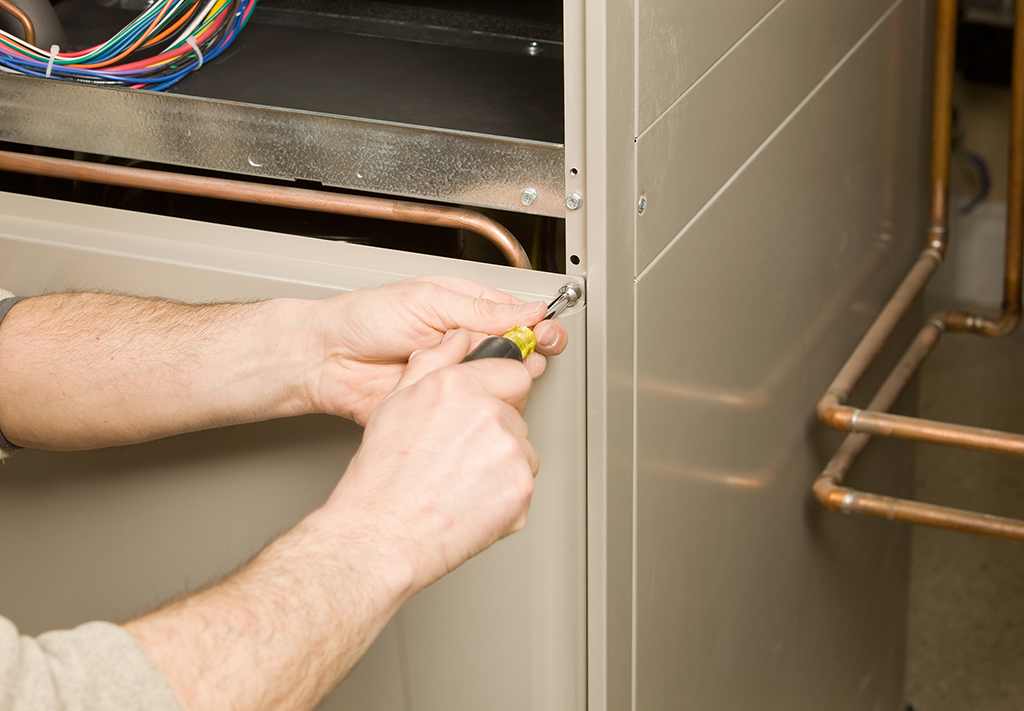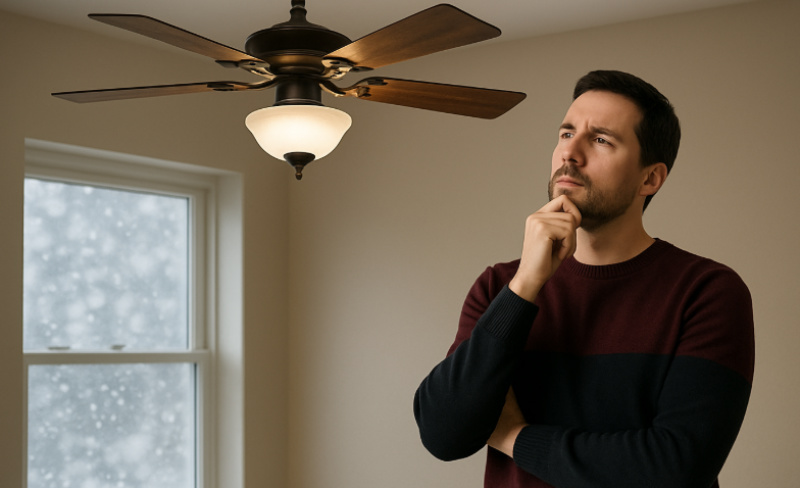Why Your Furnace Pilot Light Keeps Going Out

Ever wake up to a freezing house because that stubborn pilot light quit again? It’s the kind of problem that always seems to happen at the worst possible moment. These situations usually happen during the coldest night of the year. And if you’re reading this from somewhere in Chicagoland, it’s possible that you know exactly how frustrating these unexpected shutoffs can be.
Let’s be honest – when it’s 10 below and your furnace suddenly stops working, those emergency blankets and space heaters just aren’t cutting it. Plus, there’s something seriously unnerving about a pilot light that refuses to stay lit. Is it the thermocouple? A draft? Or is there a more serious issue at play?
The good news? These temperamental pilot lights usually have a fixable cause. Let’s dig into why your pilot light keeps going out. We’ll cover everything from simple DIY solutions to signs it’s time to call in a professional for furnace repairs. Because nobody should have to wear their winter coat indoors.
What is a Furnace Pilot Light?
You’re staring at your furnace, wondering why that tiny blue flame keeps fizzling out. But hang on – do you really know what that little flame does? Let’s break down the mystery of pilot lights before we tackle why yours is being so stubborn.
The Basics of Pilot Lights
Picture this: a small flame, no bigger than a birthday candle, working round the clock to keep your home warm. That’s your pilot light. When your house gets chilly and the thermostat begs for heat, this tiny flame jumps into action. It ignites the main burners – kind of like lighting a campfire with a match. Right next to it sits the thermocouple, a safety watchdog that cuts the gas if the pilot light dies. Pretty smart, right?
Old School vs. New Tech
Got a furnace from before 2010? Then you’re probably rocking an old-school standing pilot light. These little flames burn 24/7, waiting for their moment to shine. But newer furnaces? They’ve ditched the always-on flame for electronic ignition. Some fire up only when needed, while others use electric heating elements – no flame required. Sure, these newfangled systems save about nine bucks a month on gas bills. But here in Chicagoland, thousands of homes still depend on those trusty pilot lights to keep winter’s bite at bay.
How the Pilot Light Works
Ready for a behind-the-scenes peek at your furnace’s inner workings? Understanding this mini flame’s job might help you spot trouble before you’re stuck shivering in your slippers.
The Heat-Making Tool
Here’s what happens when your thermostat screams for warmth: That steady pilot flame sits there, burning a tiny stream of gas through a small tube. When your house gets cold, your thermostat activates, opening the main gas valve. And then gas flows to the burners, and your pilot light becomes the spark that starts the fire. Think of it like passing the Olympic torch, but instead of running through streets, your pilot light passes its flame to the burners that heat your home.
The Gas and Flame Dance
But here’s the tricky part – your pilot light needs just the right amount of gas and air to stay lit. Too much gas? Your flame turns yellow and lazy. Too little? It’ll sputter and die faster than a campfire in the rain. That blue flame you see should be steady, about 2 inches tall, and shaped like a small arrowhead.
When everything’s working right, this delicate balance keeps your furnace running smooth as butter. But one tiny hiccup in gas pressure or airflow? That’s when the trouble starts.
The Role of the Thermocouple
Let’s talk about your thermocouple. This little safety tool might be causing your pilot light problems, but trust us, you definitely want it on duty. Without it, your cozy home could turn into a dangerous situation faster than a Chicagoland snowstorm can mess up your morning commute.
Safety First
Think of the thermocouple as your furnace’s personal bodyguard. This metal rod sits right in your pilot light’s flame, and it’s got one job: making sure gas only flows when there’s a flame to burn it. When the pilot light heats up the thermocouple to about 325 degrees, it creates a tiny electrical current – we’re talking millivolts here – that keeps the gas valve open.
Pretty clever, right? Without this watchdog, gas could flood your basement if the pilot light went out – and nobody wants that nightmare scenario. The whole process happens in less than 30 seconds, which is why you need to hold down that pilot light button when lighting it.
When Good Thermocouples Go Bad
But here’s the catch – thermocouples wear out over time, usually after about 5-10 years of service. Maybe it’s gotten weak and can’t generate enough juice to keep that gas valve open. Or perhaps it’s covered in soot and can’t feel the flame’s heat properly. Sometimes it’s just bent out of position, sitting too far from the pilot flame to get hot enough.
When your thermocouple starts failing, it’s like having an overly cautious security guard – it keeps shutting down the gas even when everything’s fine. Your pilot light goes out, you relight it, and poof – an hour later, you’re back to square one in the cold. The good news? A new thermocouple only costs about $20, though getting it installed might run you closer to around a hundred bucks.
Drafts and Airflow Issues
Think your pilot light’s just being finicky? Not so fast. Sometimes the culprit is as simple as unwanted air sneaking around your furnace. And here in the Windy City, we know a thing or two about stubborn drafts.
The Draft Dilemma
Even if your pilot light might look tough, it’s actually pretty delicate. Even a small draft can blow it out or make it dance around too much to heat the thermocouple properly. Furnaces need good airflow to work right, but too much air in the wrong places? That’s when things get messy. Cracked heat exchangers, loose vent connections, or even a dirty burner assembly can create weird air currents that mess with your pilot light.
Chicagoland’s Draft Hotspots
Let’s face it – our vintage Chicago homes and their classic basements are basically draft magnets. Those old basement windows with crumbling caulk? Draft central. That rim joist where your house meets the foundation? Might as well be a wind tunnel. Even that dryer vent across the room can create enough air movement to bully your pilot light. And don’t even get us started on those mysterious basement drafts that show up every time a freight train rumbles by. The worst part? Winter’s the prime time for these drafts to kick up, right when you need that pilot light most.
Dirty or Clogged Pilot Orifice
Ever tried drinking a milkshake through a clogged straw? That’s basically what your pilot light deals with when its orifice gets gunked up. And just like that frustrating last sip, a clogged pilot orifice means your flame’s not getting the fuel it needs. This problem’s especially common in older Chicagoland homes where furnaces have been chugging along through decades of dust and debris.
The Dirty Details
That tiny hole where gas flows to your pilot light? It’s smaller than a pinhead – we’re talking about 0.016 inches here – which means it doesn’t take much to cause trouble. Over time, dust, rust, spider webs, and good old-fashioned soot build up around and inside this teensy opening. Even microscopic particles from your basement air can stick together and create a mess. Those renovation projects upstairs? That fine drywall dust finds its way everywhere. Running a humidifier? The minerals in our water can leave deposits too. The result? Your pilot light starts looking weak and yellow instead of its usual bright blue.
From Bad to Worse
Here’s where things get really annoying. Once that orifice starts getting clogged, it’s like a downward spiral. Less gas means a weaker flame. A weaker flame means more soot. More soot means even less gas can squeeze through. That perfect blue flame should be about 2 inches tall and shaped like an arrowhead – but with a dirty orifice, you might see a flickering orange flame barely reaching half an inch.
Before you know it, your pilot light’s gasping for fuel like a marathon runner hitting the wall. And just like that runner, it eventually gives up and conks out completely. This usually happens right when you’re hosting the whole family for the holidays or during one of those lovely polar vortex nights. The good news? A professional cleaning is usually affordable, way cheaper than replacing parts or, worse, dealing with frozen pipes.
Gas Supply Problems
Sometimes your pilot light troubles have nothing to do with your furnace at all. Let’s talk about gas supply issues – the behind-the-scenes drama that can leave your pilot light unstable. And in Chicagoland’s aging infrastructure, this happens more often than you’d think.
The Pressure’s Off
Your pilot light needs steady gas pressure. When that pressure drops, things get wonky fast. You might notice your pilot light looking smaller than usual, or maybe your gas stove’s flames are acting lazy too. That’s your first clue something’s up with your gas supply. The tricky part? The problem could be anywhere from the gas company’s main line to your home’s meter to those old pipes snaking through your walls.
Chicagoland’s Gas Game
Our city’s gas infrastructure is like that 100-year-old bungalow down the block – full of character but showing its age. Those bitter winter nights when everyone’s cranking their heat? The whole neighborhood’s competing for gas, and sometimes there just isn’t enough pressure to go around.
Add in those notorious lake-effect storms that can mess with gas meters, or construction crews accidentally hitting gas lines (which happens more than you’d think), and suddenly your pilot light’s playing hide-and-seek. Even those ancient gas lines under our streets can develop tiny leaks over time, causing pressure drops that make your pilot light throw in the towel.
Flame Sensor Malfunctions
Here’s a fun fact that’s not so fun when you’re freezing: sometimes your pilot light is working perfectly fine, but your furnace thinks it’s out. Meet the flame sensor – the picky eater of furnace parts that’s probably causing your headaches.
The Sensor Situation
Think of your flame sensor as your furnace’s eyes. This little metal rod needs to actually see the pilot light flame to tell your furnace “hey, it’s safe to keep the gas flowing.” When it’s working right, it’s like a reliable security camera. But just like a camera lens can get smudged, your flame sensor can get covered with a layer of gunk that blocks its view. Even a fingerprint from that time you poked around in there can cause problems. Pretty sensitive stuff, right?
When Sensors Get Cranky
Over time, that sensor can get coated with all sorts of nasty stuff – soot, corrosion, even mineral deposits from our lovely water. When that happens, it’s like trying to see through a dirty windshield on a foggy morning. The pilot light could be burning away happily, but if the sensor can’t detect it properly? Click – everything shuts down. You might notice your furnace trying to light several times before giving up completely, or the pilot light might stay lit for a few hours before the sensor throws another tantrum. The most challenging part is this does not happen all at once but gradually.
Furnace Age and Wear
Let’s talk about your furnace’s age – because like that trusty old car in your garage, sometimes reliability issues are just a matter of too many miles on the odometer. And in Chicagoland’s older homes, some furnaces have been keeping families toasty for many years.
The Age Factor
Just like we get creaky joints as we age, furnaces develop their own senior moments. After 15-20 years of faithful service, parts start wearing out faster than winter boots in February. That pilot assembly that’s lit up a million times? Those gas valves that have opened and closed through countless cold snaps? They’re like a baseball glove that’s caught too many games – still working, but definitely not in their prime. Even the metal itself gets tired, developing tiny cracks and weak spots that mess with gas flow.
Old School Problems
Here’s the real issue about aging furnaces – they’re from an era when parts were built differently. Those original components might have been bomber-tough, but try finding exact replacements today. Modern parts sometimes don’t quite fit right, or they work differently than the originals. Plus, decades of expanding and contracting through extreme temperature swings take their toll. Your furnace might be dealing with corroded gas lines, worn-out valve seats, and connections that have loosened up more than your favorite sweater. When multiple parts start showing their age at once, that pilot light becomes very unreliable.
Additional Causes of Pilot Light Failure
Just when you think you’ve figured out why your pilot light’s being difficult, surprise – there’s more! Let’s dig into some sneaky problems that often fly under the radar. These troublemakers might not be as obvious as a dirty sensor or weak gas pressure, but they can definitely send your pilot light packing.
The Heat Exchanger
Nobody wants to hear the words “cracked heat exchanger,” but it happens – especially in older homes where furnaces work overtime. Think of your heat exchanger like a car’s radiator. When it cracks (usually from years of expanding and contracting), it messes with everything. Weird air patterns develop inside your furnace, pushing and pulling at your pilot light like a mini tornado. Even tiny cracks can create enough draft to make your pilot light dance around or fizzle out. The worst part? You might not even know you’ve got a crack until your pilot light starts acting up.
The Moisture Menace
Let’s talk about Chicagoland basement dampness – you know, that lovely muggy feeling that makes everything feel slightly wet? That moisture is your pilot light’s biggest problem. Those humid summer days when your dehumidifier’s working overtime? That dampness can actually corrode furnace components faster than usual. Add in those lovely spring floods that seem to hit every other year, and you’ve got a recipe for pilot light problems. Even normal condensation from your furnace can create enough moisture to mess with the flame if your venting isn’t working perfectly.
Don’t Let a Failed Pilot Light Leave You in the Cold
Look, an unstable pilot light isn’t just annoying – it could be your furnace crying out for help. And when Chicagoland’s infamous winter winds come howling, you don’t want to play games with your heating system. When tomorrow is too late, you need an expert on the job today.
Since 1992, Precision Today has been keeping Chicagoland families toasty warm and comfortable, even during the most brutal cold snaps. Our highly trained and certified heating technicians don’t just fix pilot lights – they solve problems at the source to ensure your home systems operate at peak performance. Plus, with our Zero Problems Plan, you’ll never have to worry about surprise furnace failures again. And since we really care about quality, we give excellent warranties.
Give us a call at (630) 425-8995. With over 30 years in the industry and same-day service, we’ll have your furnace running reliably in no time.



Join the Precision Today Zero Problems Plan! As a member, you’ll receive all these benefits and more:
- Seasonal HVAC Maintenance
- Priority service
- No dispatch fees
- Transferrable membership
- 10% discount on future repairs
When you sign up for the Zero Problems Plan, you'll gain access to exclusive discounts, providing everyday savings on the services you need.
Ready to streamline your plumbing, heating, cooling, and electrical maintenance needs? Join today by calling (630) 425-8995.







